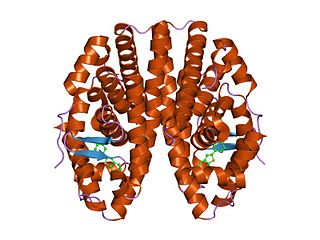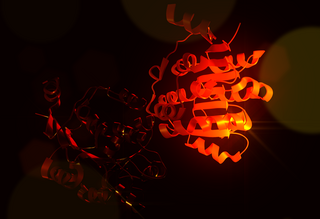Cbp/p300-interacting transactivator 1 is a protein that in humans is encoded by the CITED1 gene. [5] [6] [7]
Cbp/p300-interacting transactivator 1 is a protein that in humans is encoded by the CITED1 gene. [5] [6] [7]
CITED1 has been shown to interact with HSPA8 [8] and EP300. [8]

Histone acetyltransferase p300 also known as p300 HAT or E1A-associated protein p300 also known as EP300 or p300 is an enzyme that, in humans, is encoded by the EP300 gene. It functions as histone acetyltransferase that regulates transcription of genes via chromatin remodeling by allowing histone proteins to wrap DNA less tightly. This enzyme plays an essential role in regulating cell growth and division, prompting cells to mature and assume specialized functions (differentiate), and preventing the growth of cancerous tumors. The p300 protein appears to be critical for normal development before and after birth.

SMAD family member 6, also known as SMAD6, is a protein that in humans is encoded by the SMAD6 gene.

Activin receptor type-1B is a protein that in humans is encoded by the ACVR1B gene.

P300/CBP-associated factor (PCAF), also known as K(lysine) acetyltransferase 2B (KAT2B), is a human gene and transcriptional coactivator associated with p53.

The nuclear receptor coactivator 2 also known as NCoA-2 is a protein that in humans is encoded by the NCOA2 gene. NCoA-2 is also frequently called glucocorticoid receptor-interacting protein 1 (GRIP1), steroid receptor coactivator-2 (SRC-2), or transcriptional mediators/intermediary factor 2 (TIF2).

The nuclear receptor coactivator 3 also known as NCOA3 is a protein that, in humans, is encoded by the NCOA3 gene. NCOA3 is also frequently called 'amplified in breast 1' (AIB1), steroid receptor coactivator-3 (SRC-3), or thyroid hormone receptor activator molecule 1 (TRAM-1).

Retinoid X receptor alpha (RXR-alpha), also known as NR2B1 is a nuclear receptor that in humans is encoded by the RXRA gene.

E3 SUMO-protein ligase PIAS4 is one of several protein inhibitor of activated STAT (PIAS) proteins. It is also known as protein inhibitor of activated STAT protein gamma, and is an enzyme that in humans is encoded by the PIAS4 gene.

C-terminal-binding protein 1 also known as CtBP1 is a protein that in humans is encoded by the CTBP1 gene. CtBP1 is one of two CtBP proteins, the other protein being CtBP2.

Probable ATP-dependent RNA helicase DDX5 also known as DEAD box protein 5 or RNA helicase p68 is an enzyme that in humans is encoded by the DDX5 gene.

Transcription initiation factor TFIID subunit 2 is a protein that in humans is encoded by the TAF2 gene.

Tripartite motif-containing 24 (TRIM24) also known as transcriptional intermediary factor 1α (TIF1α) is a protein that, in humans, is encoded by the TRIM24 gene.

General transcription factor II-I repeat domain-containing protein 1 is a protein that in humans is encoded by the GTF2IRD1 gene.

Homeobox protein DLX-3 is a protein that in humans is encoded by the DLX3 gene.

Krueppel-like factor 10 is a protein that in humans is encoded by the KLF10 gene.

Cbp/p300-interacting transactivator 2 is a protein that in humans is encoded by the CITED2 gene.

Helicase SRCAP is an enzyme that in humans is encoded by the SRCAP gene.

Smad nuclear-interacting protein 1 is a protein that in humans is encoded by the SNIP1 gene.

Transcription factor RFX3 is a protein that in humans is encoded by the RFX3 gene.

In molecular biology, TAZ zinc finger domains are zinc-containing domains found in the homologous transcriptional co-activators CREB-binding protein (CBP) and the P300. CBP and P300 are histone acetyltransferases that catalyse the reversible acetylation of all four histones in nucleosomes, acting to regulate transcription via chromatin remodelling. These large nuclear proteins interact with numerous transcription factors and viral oncoproteins, including p53 tumour suppressor protein, E1A oncoprotein, MyoD, and GATA-1, and are involved in cell growth, differentiation and apoptosis. Both CBP and P300 have two copies of the TAZ domain, one in the N-terminal region, the other in the C-terminal region. The TAZ1 domain of CBP and P300 forms a complex with CITED2, inhibiting the activity of the hypoxia inducible factor (HIF-1alpha) and thereby attenuating the cellular response to low tissue oxygen concentration. Adaptation to hypoxia is mediated by transactivation of hypoxia-responsive genes by hypoxia-inducible factor-1 (HIF-1) in complex with the CBP and p300 transcriptional coactivators.